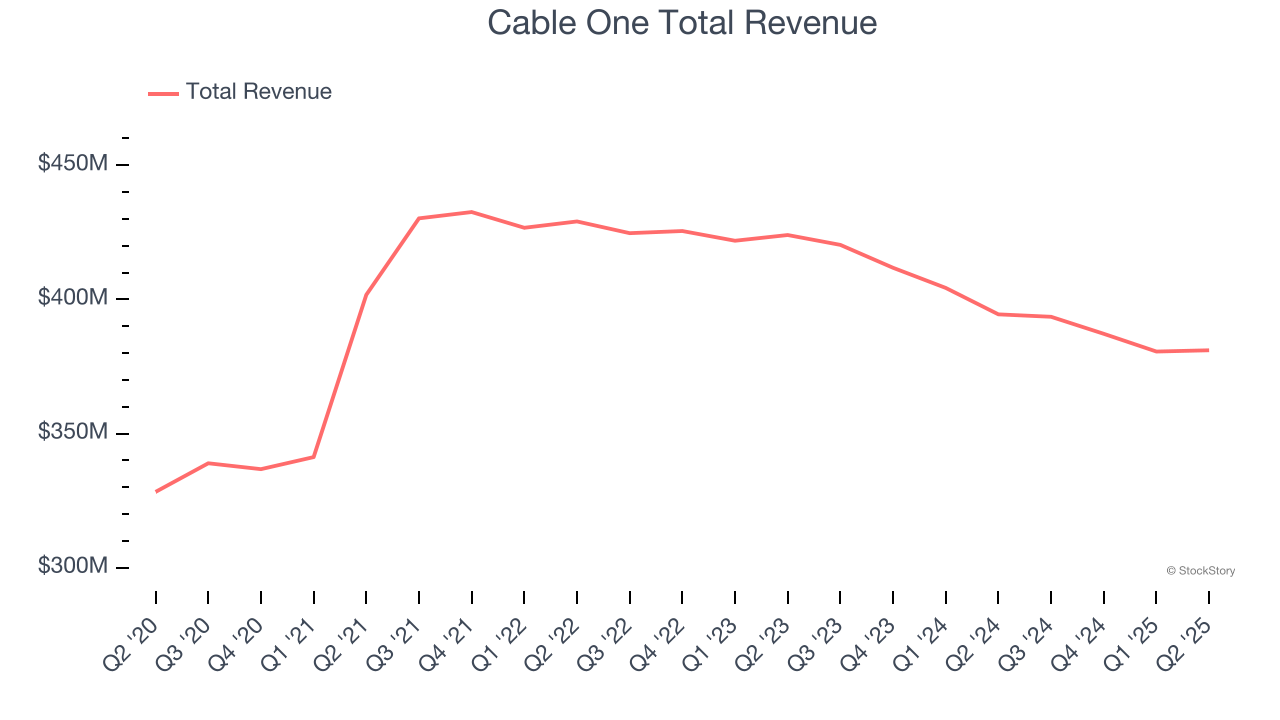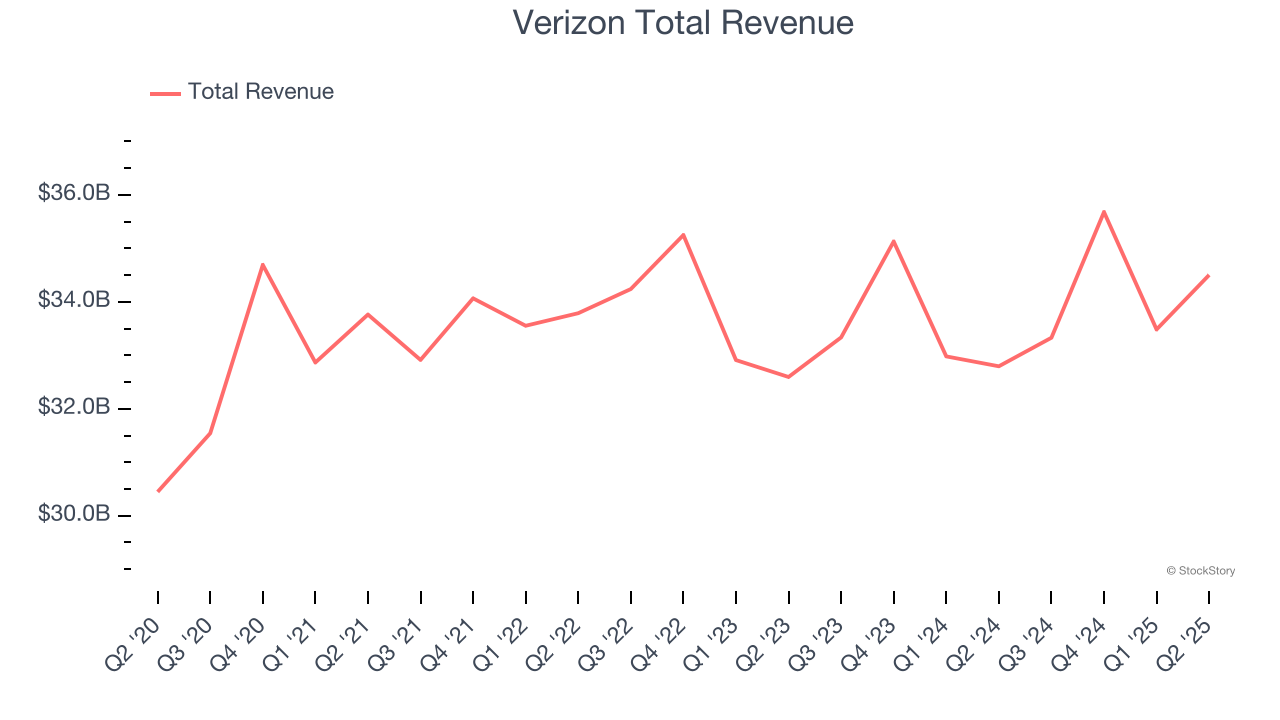
As the Q2 earnings season wraps, let’s dig into this quarter’s best and worst performers in the wireless, cable and satellite industry, including Cable One (NYSE: CABO) and its peers.
The massive physical footprints of cell phone towers, fiber in the ground, or satellites in space make it challenging for companies in this industry to adjust to shifting consumer habits. Over the last decade-plus, consumers have ‘cut the cord’ to their landlines and traditional cable subscriptions in favor of wireless communications and streaming video. These trends do mean that more households need cell phone plans and high-speed internet. Companies that successfully serve customers can enjoy high retention rates and pricing power since the options for mobile and internet connectivity in any geography are usually limited.
The 8 wireless, cable and satellite stocks we track reported a slower Q2. As a group, revenues beat analysts’ consensus estimates by 0.8%.
Thankfully, share prices of the companies have been resilient as they are up 6.5% on average since the latest earnings results.
Cable One (NYSE: CABO)
Founded in 1986, Cable One (NYSE: CABO) provides high-speed internet, cable television, and telephone services, primarily in smaller markets across the United States.
Cable One reported revenues of $381.1 million, down 3.4% year on year. This print was in line with analysts’ expectations, but overall, it was a slower quarter for the company with a significant miss of analysts’ adjusted operating income and EPS estimates.

Interestingly, the stock is up 21.5% since reporting and currently trades at $155.50.
Read our full report on Cable One here, it’s free.
Best Q2: Verizon (NYSE: VZ)
Formed in 1984 as Bell Atlantic after the breakup of Bell System into seven companies, Verizon (NYSE: VZ) is a telecom giant providing a range of communications and internet services.
Verizon reported revenues of $34.5 billion, up 5.2% year on year, outperforming analysts’ expectations by 2.3%. The business had a satisfactory quarter with a beat of analysts’ EPS estimates.

Verizon delivered the biggest analyst estimates beat and fastest revenue growth among its peers. The company added 162,000 customers to reach a total of 146.1 million. The market seems happy with the results as the stock is up 10.3% since reporting. It currently trades at $45.02.
Is now the time to buy Verizon? Access our full analysis of the earnings results here, it’s free.
Slowest Q2: WideOpenWest (NYSE: WOW)
Initially started in Denver as a cable television provider, WideOpenWest (NYSE: WOW) provides high-speed internet, cable, and telephone services to the Midwest and Southeast regions of the U.S.
WideOpenWest reported revenues of $144.2 million, down 9.2% year on year, in line with analysts’ expectations. It was a disappointing quarter as it posted a significant miss of analysts’ adjusted operating income estimates and a significant miss of analysts’ EPS estimates.
WideOpenWest delivered the slowest revenue growth in the group. Interestingly, the stock is up 49.2% since the results and currently trades at $5.08.
Read our full analysis of WideOpenWest’s results here.
Sirius XM (NASDAQ: SIRI)
Known for its commercial-free music channels, Sirius XM (NASDAQ: SIRI) is a broadcasting company that provides satellite radio and online radio services across North America.
Sirius XM reported revenues of $2.14 billion, down 1.8% year on year. This result met analysts’ expectations. Zooming out, it was a mixed quarter as it also recorded a beat of analysts’ EPS estimates but a miss of analysts’ adjusted operating income estimates.
The stock is down 3.4% since reporting and currently trades at $22.17.
Read our full, actionable report on Sirius XM here, it’s free.
AT&T (NYSE: T)
Founded by Alexander Graham Bell, AT&T (NYSE: T) is a multinational telecomm conglomerate providing a range of communications and internet services.
AT&T reported revenues of $30.85 billion, up 3.5% year on year. This print beat analysts’ expectations by 1.3%. More broadly, it was a mixed quarter as it underperformed in some other aspects of the business.
The stock is up 6.8% since reporting and currently trades at $29.27.
Read our full, actionable report on AT&T here, it’s free.
Market Update
As a result of the Fed’s rate hikes in 2022 and 2023, inflation has come down from frothy levels post-pandemic. The general rise in the price of goods and services is trending towards the Fed’s 2% goal as of late, which is good news. The higher rates that fought inflation also didn't slow economic activity enough to catalyze a recession. So far, soft landing. This, combined with recent rate cuts (half a percent in September 2024 and a quarter percent in November 2024) have led to strong stock market performance in 2024. The icing on the cake for 2024 returns was Donald Trump’s victory in the U.S. Presidential Election in early November, sending major indices to all-time highs in the week following the election. Still, debates around the health of the economy and the impact of potential tariffs and corporate tax cuts remain, leaving much uncertainty around 2025.
Want to invest in winners with rock-solid fundamentals? Check out our Top 5 Growth Stocks and add them to your watchlist. These companies are poised for growth regardless of the political or macroeconomic climate.
StockStory is growing and hiring equity analyst and marketing roles. Are you a 0 to 1 builder passionate about the markets and AI? See the open roles here.




